Hair loss is a common concern that affects a significant portion of the male population. While various factors contribute to hair loss, one particular hormone stands out as a key player in this process. In this article, we will delve into the hormone that causes hair loss in males, exploring its role, mechanisms, and potential remedies. By understanding the relationship between this hormone and hair loss, individuals can make informed decisions about managing and preventing its effects.
Testosterone’s Role in Hair Loss
Testosterone is a crucial male sex hormone that plays a vital role in the development of male characteristics. It contributes to muscle growth, bone density, and the deepening of the voice. However, as men age, some testosterone is converted into another hormone called dihydrotestosterone (DHT) through an enzyme called 5-alpha reductase. This conversion sets the stage for the onset of hair loss.
The Impact of DHT on Hair Follicles
DHT binds to hair follicles’ receptors, causing them to shrink over time. This process, known as miniaturization, leads to thinner and weaker hair strands. Eventually, affected hair follicles become incapable of producing new, healthy hair. The shrinking follicles result in shorter growth cycles and longer resting phases, ultimately leading to hair thinning and balding.
Can genetics cause hair loss?
Genetics also play a significant role in determining an individual’s sensitivity to DHT. People with a family history of male-pattern baldness are more likely to inherit genes that make them susceptible to the effects of DHT on hair follicles. This genetic predisposition, combined with the presence of excess DHT, accelerates the process of hair loss.
Understanding Androgenetic Alopecia
Androgenetic alopecia, commonly known as male-pattern baldness, is the most prevalent form of hair loss in men. It is primarily attributed to the effects of DHT on hair follicles. This condition follows a distinct pattern, starting with a receding hairline and thinning crown. Over time, the hair loss may progress to leave a horseshoe-shaped hair pattern on the scalp.
When is male pattern baldness?
Male pattern baldness, also known as androgenetic alopecia, typically begins to manifest in genetically predisposed men during adulthood. It commonly starts between the ages of 20 and 40, although it can occur earlier or later. Male pattern baldness follows a predictable pattern, often beginning with a receding hairline and thinning at the crown of the head. The rate and extent of hair loss can vary, with some men experiencing more aggressive hair loss than others. Hormonal factors, genetics, and age-related changes contribute to the onset and progression of male pattern baldness.
Can Male Hormone Hair Loss Be Treated?
Yes, male hormone-related hair loss, specifically androgenetic alopecia or male pattern baldness, can be treated. Several treatment options aim to slow down hair loss, promote hair regrowth, or improve the appearance of existing hair. Here are some approaches:
1. Medications:
Finasteride:
This oral medication reduces the production of the hormone dihydrotestosterone (DHT), which is linked to hair loss.
Minoxidil:
A topical solution applied to the scalp, minoxidil promotes hair growth and slows hair loss.
2. Topical Therapies:
Low-Level Laser Therapy (LLLT):
Devices emitting low-level laser light can stimulate hair follicles and promote regrowth.
Topical DHT Blockers:
Some shampoos and serums contain DHT-blocking ingredients to slow hair loss.
3. Hair Restoration Procedures:
Follicular unit transplantation (FUT) or follicular unit extraction (FUE) transplant healthy hair follicles to areas of thinning or baldness.
Platelet-Rich Plasma (PRP) Therapy:
PRP injections contain growth factors that can stimulate hair follicles.
4. Hair Care and Styling:
Proper Hair Care:
Gentle hair care practices can minimize damage and improve the appearance of existing hair.
Hairstyling:
Opting for suitable hairstyles can help conceal thinning areas.
5. Consultation with Professionals:
Consulting a dermatologist or hair specialist is crucial for proper diagnosis and treatment recommendations.
While treatments can be effective, results vary among individuals. It’s important to manage expectations, adhere to treatment protocols, and consult professionals for personalized guidance based on your specific hair loss pattern and needs.
See Also: Can Exercise Help with Hair Loss? Exploring the Connection
Conclusion
In conclusion, hair loss in males is largely influenced by the hormone DHT, which is derived from testosterone. Genetic predisposition, coupled with factors like age and lifestyle choices, contribute to the severity of hair loss. Understanding the mechanisms behind male-pattern baldness empowers individuals to make informed decisions about potential treatments, whether through medications, topical solutions, or surgical interventions. By addressing the hormonal and genetic factors involved, men can take proactive steps to manage and mitigate the effects of hair loss.


